[ad_1]
We know them in death. We know how they died, some of what they ate, how they grew, where they may have roamed, and even if they suffered from disease or injury. Preserved bones can tell us a lot, but perhaps just as interesting are the stories they left in traces, where their behavior, even for one moment, is captured in stone. Trace fossils—things like preserved footprints, scat, and nests—offer an intimate view to creatures that no longer inhabit this planet, demonstrating that ancient life may have been majestic, ferocious, and nimble, but it also had its mishaps, and it could be just as weird and disgusting as life today.
Clumsy Giants
Take sauropods. Their size alone evokes images of grandeur, a view reinforced by museum displays of these enormous long-necked dinosaurs and their subsequent portrayal in films. But surely there were moments when these creatures weren’t as stately.
This is exactly what Arturo Heredia, Pablo Pazos, and Diana Elizabeth Fernández describe in a recent paper published in the Geological Society, London, Special Publications. In it, we find evidence of a young group of sauropods slipping along a tidal channel 130 million years ago.
Their footprints were on Rayoso Hill in the Neuquén Province. It’s just one part of a rich Lower Cretaceous unit within Argentina known as the Agrio Formation, and it’s filled with remarkable and copious trace fossil preservation. At Rayoso Hill, the details from this tidal flat ecosystem are astounding, including water height marks, a large series of preserved sedimentary ripples from an ancient flood tide, and an ancient horseshoe crab (xiphosurid) mating ground. Based on the size and shape of the footprints, the team determined these were young sauropods of various ages walking and slipping parallel to a tidal channel.
What these footprints actually were was not immediately apparent. The team ruled out feeding traces of large marine reptiles such as plesiosaurs or ichthyosaurs. Feeding traces would be deeper at one end, which is not seen in these tracks. Moreover, the amount of water available in the last set of tracks would make it unlikely that an aquatic creature (fish or marine reptile) could make them. Nor were they fish resting or fish predation traces for a number of reasons: the morphology doesn’t match, there is no evidence of sediment excavation as there would be with predation, and most fish wouldn’t be heavy enough to make that sort of trace. Theropods or sauropods, on the other hand, would have been. It was easy to dismiss theropods, however, as the footprints weren’t three-toed, as bipedal theropods are known to be. Crescent-shaped prints, the hallmark of sauropods, could be found among them, and this was the biggest clue.
G/O Media may get a commission
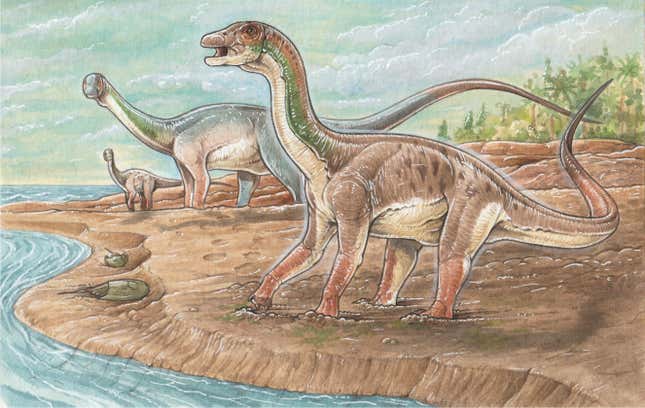
Analyzing some of the sediments within the footprints with a scanning electron microscope, they determined the reason this group of young sauropods lost their footing was due to a slippery microbial mat. These layered blankets of microorganisms such as cyanobacteria also exist today. Not only did it cause these dinosaurs to slip, but that microbial mat—along with the environment of that tidal flat—may have also helped preserve their footprints. But how?
Arturo Heredia is lead author on this paper and a CONICET postdoctoral fellow at the Instituto de Estudios Andinos Don Pablo Groeber (IDEAN). Consider, Heredia explained in a video interview, the various ways in which today’s footprints may or may not be preserved when walking along a beach. Walk too close to the water, and the energy of a wave or tide can erase them. Too far up into dry sand, and wind or loose sand grains fail to keep the footprint shape intact. But walking just close enough to the water, where the sand is neither too dry nor too wet, and the footprint will retain its shape. This, he said, holds true for ancient traces as well. “The water content in sediment,” he explained, is “important to preserve the footprint morphology.”
Humidity is equally important for the growth of microbial mats. Some cyanobacteria contain filaments, and “they trap the sediments like a mesh,” he said, so that if something like a sauropod walks along this microbial mat and slips, those footprints will retain their elongated shape, thanks to the binding of grains within those mats. By doing so, he added, this provides “enough time for them to be covered by sediment and continue on the way to being preserved in the fossil record.”
Microbial mats certainly help trace fossil preservation, but, according to co-author Diana Elizabeth Fernández, a CONICET researcher also at IDEAN (CONICET-UBA), more trace fossils are preserved without them. The past two decades, she said in a video interview, have increased our understanding of microbial mats in relation to trace fossils, including the fact that microbial mats “are more common than we used to think.” Notably, she added, microbial mats “help in the quality of preservation. And in this case, they were necessary, of course, for this surface to be slippery in itself.”
Her former PhD advisor and co-author on the paper, Pablo Pazos, was the first to see the tracks about 10 years ago as she was studying the nearby horseshoe crab traces. “He has an extremely acute eye,” she said. “Besides working in ichnology, he’s a sedimentologist, so his background is geology. He’s very good at looking at details. We were lucky, because we were working there at the time where the sun would hit that surface with a certain angle. And you could see everything accentuated. Every relief accentuated. We didn’t know what they were, but we knew that it was definitely something that was clumsy!”
A Predator’s Slip?
Clumsiness certainly wasn’t specific to sauropods, and possible evidence of that was found off the coast in Yorkshire, UK. Millions of years before the young group of sauropods even existed, an enormous theropod—a bipedal dinosaur predator—left one large and unique footprint. It has the three toe prints and claws of a theropod, but the heel stretches much farther back, an extension not seen in other similar footprints. The authors of a paper published in the Proceedings of the Yorkshire Geological Society offer three possible explanations: 1. This dinosaur may have been crouched low or laying upon the ground in a resting position, 2. It may be the trace of the dinosaur as it slid forward from a squatting position, or 3. This may be evidence that it slipped. With only one footprint, it’s hard to ascertain anything definitively.
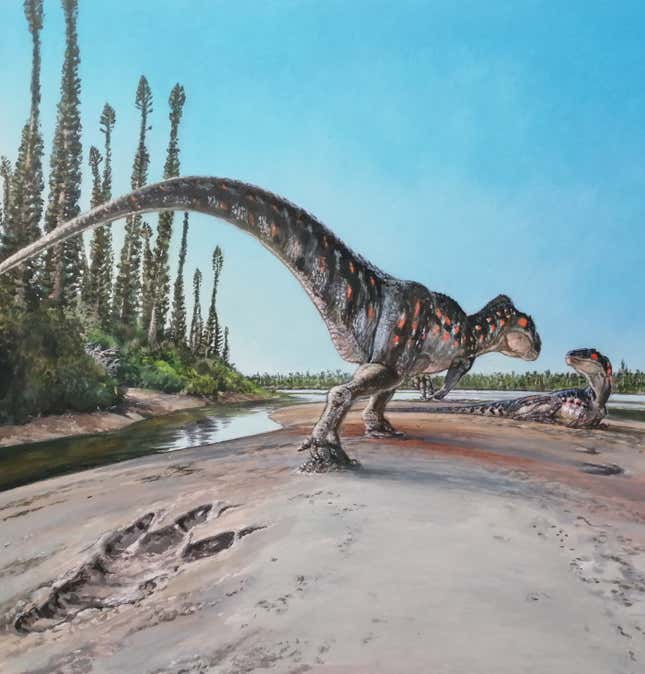
But even that one trace fossil offers tantalizing information about the animal that made it. Skin impressions are preserved suggesting padded feet, and, based on the size of the footprint, they can estimate the hip height: a terrifying 2.5 to 3 meters (approximately 8 to almost 10 feet).
“It would have weighed in the region of 1.5 – 2 tonnes,” lead author and geologist John Hudson explained by email. This points to the carnivorous Megalosaurus as the possible print maker, a dinosaur that lived in England during the Middle Jurassic around 165 million to 175 million years ago. This particular animal would have been approximately 6 to 8 meters (about 19 to 29 feet) long.
“This,” Hudson said, “would be the top predator at the time.”
And, like the sauropod prints, this footprint was found in a relatively wet environment, in an area where “there was never one main river system but multiple meandering distributary channels with overbank deposits, sheet flood events, and crevasse splays,” Hudson explained. Fossil pollen and spores indicate this area was home to a number of conifers and plants. These details about this ecosystem, one that Hudson says “does not exist anywhere in the world today,” offer exciting insight into an ancient world.
“When we study body fossils of extinct animals, we can never be certain sometimes if they are in situ,” Hudson stated. “With trace fossils, they are often preserved where the animal walked, so when we investigate a site, every possible line of evidence is taken into account, body fossils, trace fossils, any environment clues like local flora to give us a more complete view of the site at the time it existed.”
Creased Skin
Although clumsiness was not a factor in footprints found in the Boskovice Basin in the Czech Republic, what is absolutely remarkable is that they, too, left skin impressions. They also offer evidence of species that have, so far, left no body fossils in the area. These are trace fossils from animals that lived during the early Permian, approximately 293 million to 299 million years ago. In other words, from a distance in time that is staggeringly difficult to fathom, paleontologists now know that these four-legged creatures (or tetrapods) existed in the area and have an idea of what the skin on the soles of their feet looked like.
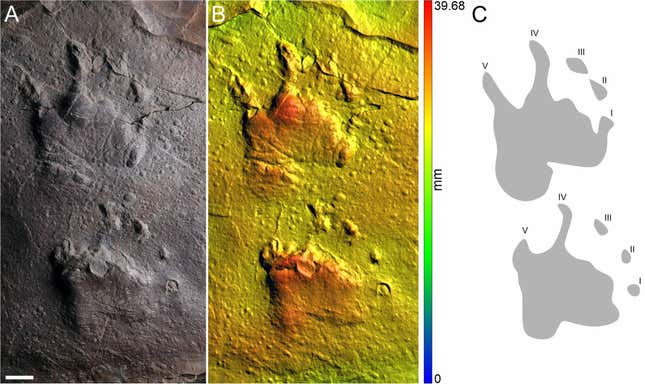
In a paper published in Scientific Reports, the team describes three sets of footprints, including a trackway, from different locations within the Czech Republic. Trace fossils are notoriously difficult to match to the species that made them, so ichnologists—those who study ichnofossils, another word for trace fossils—will name the trace itself based on its shape and size. “Every ichnologist tries to identify the closest possible trackmaker,” Gabriela Calábková, lead author and paleontologist at the Moravian Museum, wrote in an email to Gizmodo. “Unfortunately, it is often almost impossible to determine a particular trackmaker at the species or genus level, not only because it is often not preserved in the fossil record, but also because different species can leave identical footprints.”
The team narrowed it down to an early-diverging synapsid—a forerunner to mammals—and determined the prints were made by species whose body lengths would have been about 13 to 15 inches long. But that, Calábková explained, doesn’t include the tail, head, or neck. And while, compared to theropods and sauropods, it might seem tiny, “they were not so small for their time,” she said.
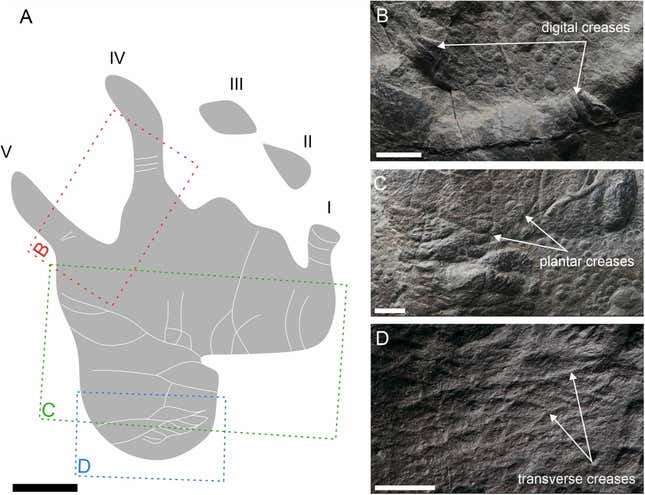
These synapsids “had a sprawling posture; they were not sprinters,” she asserted. “The erect posture allowing more efficient and faster movement on land appeared only in their therapsid descendants.”
These and other recently studied traces are significant, according to Calábková, for they have “completely changed our existing ideas about the diversity of terrestrial tetrapods in the earliest Permian of the Czech Republic.”
“It all started in 2018,” she continued, “when a fossil digger and my good friend Tomas Viktorýn brought me small traces of reptiles he had just found in the Boskovic Basin. Although these tracks were not well preserved, I was very interested, because I suspected that they had been left by animals not yet known from the Boskovice Basin. Since then, my colleague Dr. Jakub Březina from the Moravian Museum, paleo digger Tomáš Viktorýn, and I have carried out lots of fieldwork, where we have managed to find footprints not only of synapsids but also of early reptiles, large seymouriamorphs, diadectomorphs (the first herbivorous tetrapods), and large temnospondyls. It’s amazing when you can turn hours of hard work in muddy and very inaccessible terrain into a discovery that brings something completely new to our field, such as the first skin impression on the hands and feet of an early-diverging synapsid.”
Yuck—a Snack Sesh Gone Wrong
Trace fossils aren’t just made alongside wet environments; they can also be created within the water itself. Papers published in 2010 and 2015 offer surprising insight into marine creatures that may have merely been searching for a meal but instead bit into something considerably less appealing.
Evidence found in three coprolites, or fossilized feces, reveal that ancient sharks and an ancient gar—a type of long-snouted toothed fish—bit into them and then released them. As the authors note, the fact that the coprolites exist is proof they weren’t consumed, but why would animals have bitten them in the first place?

The team thinks the sharks may have chomped down to determine whether the coprolites were potential food, only to immediately spit them out. This behavior of test-biting is known in today’s sharks. But the other possibility is intriguing: could the coprolite have been part of the prey’s intestines when the shark attacked? If so, the bite mark would have remained as the coprolite left the body from an open wound, falling to the sea floor where it was eventually covered by the sediment and preserved. These coprolites were found near rocks dated to the Miocene, roughly 5 million to 23 million years ago.
Dating the gar-bitten coprolite was impossible, as it was found in a deposit from mixed time periods. Modern-day gars are known to ambush their prey. Using modeling clay, the team replicated the types of marks on this coprolite using the teeth of an extant gar. If ancient gars also ambushed intended food, then it’s possible that it was striking at prey and either missed or accidentally included the feces as well. Like the shark-bitten coprolites, it wasn’t consumed.
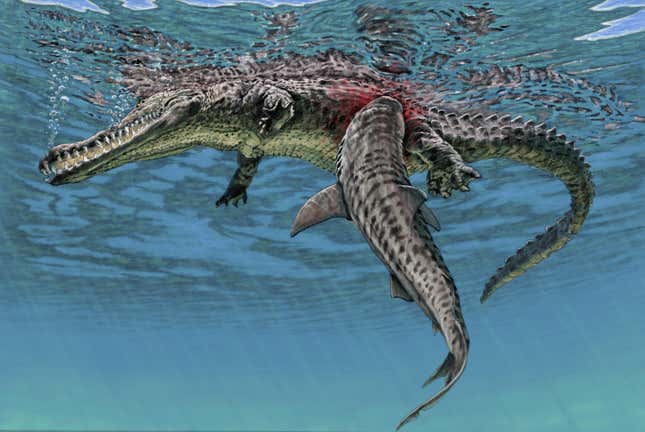
The lead author of both papers, Stephen J. Godfrey, is curator of paleontology at the Calvert Marine Museum. These fossils, he said, are examples of “exceedingly rare” composite trace fossils: a trace fossil within a fossil (in this case, coprolites with bite marks on them).
“For me,” he said, “the sheer improbability of this kind of composite trace fossil forming and being preserved is the most exciting aspect of it all. What it demonstrates is that evidence of exceedingly unlikely events can be preserved in the fossil record. So what’s the limit of what could be preserved…?”
The Social Lives of Fish
Not all water traces are potentially stomach-turning. Scientists in Argentina discovered the astonishing traces of fish from the Paleozoic, approximately 419 million to 443 million years ago. These trace fossils are described in a paper published in Palaios. As mentioned previously, ichnologists will name the trace fossil itself, as the specific trace maker is often unknown. This team named a new ichnofossil, Raederichnus dondasi: tear-drop shaped fish resting traces that provide the first and oldest evidence of shoaling behavior, or fish congregating in groups. The name derives from “raedera,” the name for a stone tool made by Indigenous Pampean hunter-gatherers in Paleolithic South America; “ikhnos” or trace from Greek; and “dondasi” from Alejandro Dondas, a field technician and self-taught paleontologist.
Raederichnus dondasi appears to be the traces of agnathan, or jawless, fishes that were resting in a shallow, subtidal zone. The team narrowed down possible fish behaviors to either reproduction or feeding. Reproduction seemed unlikely, because of the environment in which these traces were found and because of the spacing of each fossil from the others. And although ancient horseshoe crabs are well known within the Paleozoic, they also make very distinctive traces, none of which look like Raederichnus dondasi.
Lead author Karen Halpern is a paleontologist at the Universidad National de Mar del Plata.
“I had many doubts when I first saw those fossils,” she wrote to Gizmodo, explaining that determining what these trace fossils might be involved a lot of observation and contemplation. “My colleagues helped me in many ways, by discussing and arguing about many other possibilities. When we finally discarded the fact that horseshoe crabs were unlikely to be their producer, we added a fish specialist to the team, Soledad Gouiric-Cavalli. She was very excited about it!!”
“Most fish,” Halpern noted, “make nests in more quiet environments,” particularly those that would prevent predators from accessing them, such as “a river mouth where salinity is so low that no other marine predator (such as arthropods or an octopus) can live.”
That these traces were spaced out from each other was another important clue. This feeding behavior prevents competition.
“I hope that similar findings can happen elsewhere!” she added, “And if in the near future more evidence arises and our interpretation is wrong, I hope someone takes the time to write it down and publish it! That is how science works!”
An Ancient Death March
The vast majority of traces require substantial detective work to understand what may have left that fossil. But there are exciting and astonishing fossils where the tracemaker can be found within it (as in a burrow), for example, or at the end of it (as in a trackway). Millions upon millions of years after the fish left shoaling traces, an ancient horseshoe crab (limulid) not only left its signature traces walking along a seabed, but it then died and remained perfectly preserved at the very end of those tracks.
This astonishing fossil is 9.7 meters (approximately 31 feet) in length, and was originally found within the Solnhofen limestone beds in Bavaria, Germany, before making its home in the Wyoming Dinosaur Center in the U.S.

At only 12.7 centimeters, this arthropod is believed to be a juvenile. And although there is no way to know for sure, the researchers believe this little horseshoe crab may have been tossed into this toxic lagoon by a turbulent storm. Evidence suggests this was an area lacking oxygen and marked by high salinity, a lethal combination for most living things. While there are other well-preserved mortichnias—the name for trace fossils that record a creature’s death march—in limestones also discovered near Solnhofen in Bavaria, nothing else disturbed the sea floor; it was almost completely devoid of life.
This particular mortichnia tells a terribly sad but fascinating story. Step-by-step, the horseshoe crab walks, changes direction, crawls forward, and finally dies by asphyxiation. The team notes that, of the other fossils from the Solnhofen beds that show similar death marches, horseshoe crabs lasted longer than most. Crustaceans and bivalves succumbed within decimeters and centimeters. The team interprets some of the more erratic tracks as evidence the horseshoe crab was confused and distressed.
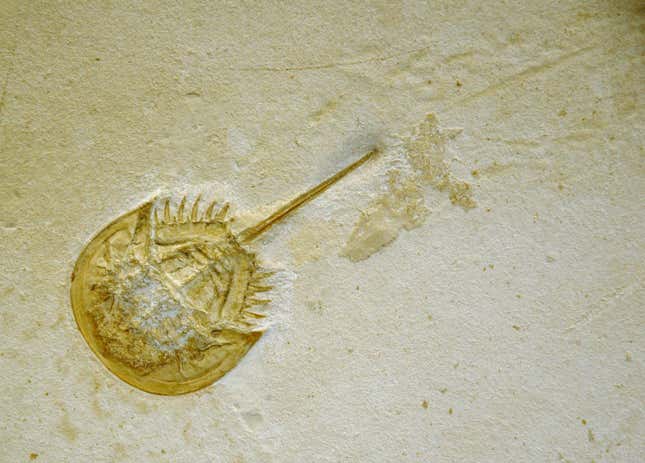
Dean Lomax, co-author on the aforementioned theropod track paper, paleontologist, scientific communicator, and author, is lead scientist on this 2012 paper published in Ichnos.
“This is one of the most spectacular fossils I have ever seen,” he wrote in an email. “I was actually introduced to this stunning fossil on my very first day volunteering at the Wyoming Dinosaur Center in 2008, aged 18.”
He described how he had paid to travel from Doncaster, England to Wyoming by selling his possessions. Even, he said, his “cherished Star Wars collection.” He volunteered there for four months and returned years later specifically to study that juvenile horseshoe crab.
“Studying this beautiful fossil, however, you cannot help but feel some sadness for the little limulid who died in such tragic circumstances. Yet in death,” he observed, “this ancient arthropod became an extraordinary story breathing new life into studying fossils.”
“The fossil left such a lasting impression,” he continued, “that it gave me the idea for a book that focused on exceptional fossils with evidence of behavior, ultimately leading to Locked in Time – Animal Behavior Unearthed in 50 Extraordinary Fossils.”
His engaging book includes more information about this mortichnia, as well as many more phenomenal body and trace fossils from various geologic time periods.
Every single one of these discoveries enriches our understanding of past life on this Earth. Many of the creatures described above don’t have any modern analogue; they are brought back to life through research, museums, books, and our imaginations in paleoart and CGI. Some of them are so far back in time and so relatively unknown to those of us in the general public that they’re hard to picture. But these behaviors aren’t. A shuffling group of young sauropods slipping, a seemingly terrifying theropod losing its footing: These are actions we can comprehend. The more trace fossils found and interpreted, the more pieces of the puzzle we put together, the more relatable extinct creatures become.
Godfrey mentioned that “we will never reach the end of the stories fossils can tell.”
It’s a wonderful thought. Perhaps through more stories, we will learn that life on this planet, no matter how foreign or distant to us today, may not be so different after all.
Jeanne Timmons (@mostlymammoths) is a freelance writer based in New Hampshire who blogs about paleontology and archaeology at mostlymammoths.wordpress.com.
[ad_2]


